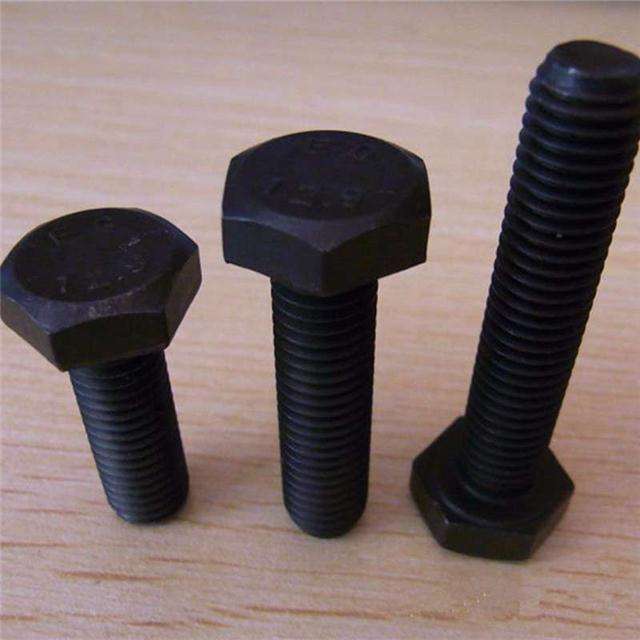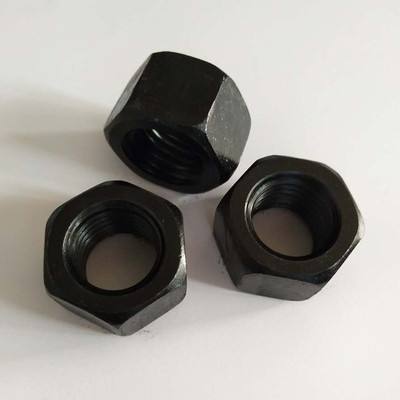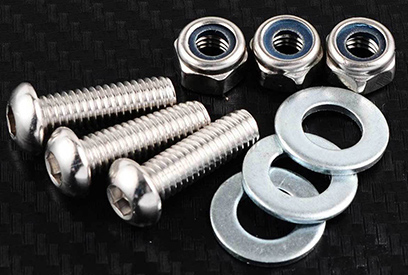1. Pollution caused by rinsing
After the fasteners were quenched, they were cleaned with a silicate cleaning agent, and then rinsed. XX solid material appeared on the surface. The material was analyzed with an infrared spectrometer, and it was confirmed that it was inorganic silicate and iron oxide. This is due to incomplete rinsing and residual silicates on the fastener surface.
2. Unreasonable stacking of fasteners
After the fasteners are tempered, there are signs of discoloration. Soak them and let them volatilize to find oily residues. These substances are high in lipids. It means that the fasteners are contaminated by cleaning agents and quenching oils during the rinsing period, and melted at the heat treatment temperature, leaving chemical burn scars. Such substances confirm that the surface of the fasteners is not clean. Analysis by the infrared spectrometer is a mixture of base oil and ether in quenching oil. The ether may come from the addition of the quench oil. The analysis results of the quenching oil in the mesh belt furnace confirmed that the fasteners are slightly oxidized in the quenching oil due to unreasonable stacking during heating, but it is almost negligible. This phenomenon is related to the cleaning process, not the quenching oil. The problem.
3. Surface residue
There is a white residue on the high-strength screw, which is confirmed to be phosphide after analysis with an infrared spectrometer. No acid cleaning agent cleaning was carried out, and the rinsing tank was inspected and found that the tank liquid had a high carbon solubility.
4. Alkali burn
High-strength screw quenching residual heat blackening has a uniform and flat oil-black outer surface. But there are orange XX visible areas in the outer ring. In addition, there are slightly bluish or reddish areas visible. The original bar and wire rod are coated with phosphating film to facilitate cold heading and tapping, heat treatment directly without rinsing, cooling in quenching oil, cleaning with the alkaline cleaning agent, drying (without rinsing), tempering at 550°C, heat treatment Remove the rust-preventive oil from the tempering furnace in a state of It has been tested that the red area on the screw is caused by alkali burns. Alkaline cleaners containing chlorides and calcium compounds will burn the steel fasteners during heat treatment, leaving marks on the surface of the fasteners. Iron and steel fasteners cannot remove surface alkalis in quenching oil, which burns the surface in the high-temperature austenite state and aggravates the damage in the next tempering. The recommendation is to thoroughly wash and rinse fasteners prior to heat treating to completely remove alkaline residues that can cause fastener burns.
5. Improper rinsing
Large-sized fasteners are often quenched with a polymer aqueous solution. Before quenching, they are cleaned and rinsed with an alkaline cleaning agent. After quenching, the fasteners have been rusted on the inside. Analysis with an infrared spectrometer confirmed that in addition to iron oxide, there were also sodium, potassium, and sulfur, indicating that there was an alkaline cleaning agent on the inside of the fastener, probably potassium hydroxide, sodium carbonate, or similar substances, which promoted its rusting. The fastener rinse is checked for excessive contamination, and it is also recommended to change the rinse water frequently. In addition, adding a rust inhibitor to the water is also a good method.
6. Excessive rust
High-strength fasteners often see some black streaks. It is also seen in the test that the fasteners before heat treatment have been rinsed with inorganic and organic cleaning agents. After quenching, black streaks are still found even after careful cleaning before heat treatment. , will also leave streaks after heat treatment. The residual pollutants on the surface were analyzed by the infrared spectrometer and found to be higher concentrations of sulfur and calcium. Using a small amount of acetic acid in isopropanol, fold a small piece of test filter paper on the black spot and wipe it, leaving the black spot on the filter paper. The filter paper was analyzed by an infrared spectrometer, and it was confirmed that calcium, sulfur, iron, manganese, and chromium were the main elements. The presence of calcium and sulfur in the rust spots indicates that the substance is the dried quenching oil, and it is also the evolution of the gas phase during the quenching process. Because the quenching oil is excessively aged, it is recommended to pour out the old oil, add new oil, and implement process supervision and quenching oil maintenance during the entire process cycle.
0








